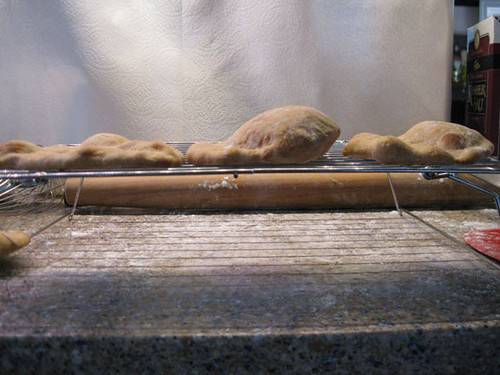I've made pitas about 3 times now and having a puffing problem. The first time I got pockets, however they were very thin on the top and thick on the bottom. Second and third times I got uneven puffing and also no puffing at all. I tried raising the oven temp - from 400, to 450, to 475. Using yeast bought a month ago, works fine in rising the dough and in my other breads. I preheated for 2 hours or so this last time, to make sure the oven was thoroughly hot. Using tiles that are always in the oven. Tried rolling and hand shaping the dough to be very thin as recommended by others on the forum. No dice. What am I doing wrong? I follow the recipe, using whole wheat and AP. The big difference I can see is the first time, I made 7 "large" pitas and the second and third times I made several smaller ones. Is it possible that somehow there's uneven temperature in the oven, or on the tiles? Sometimes even in the same batch some pitas have a pocket while others don't or just look lumpy.
[url=http://www.flickr.com/photos/tchoi/5711973429/] [/url]
[/url]
[url=http://www.flickr.com/photos/tchoi/5711973429/][/url]
Side view of problem pitas.
Hi tc,
How long do you let the pitas rest before you put them in the oven?
If during that period you bend or pinch the pitas they might dock - the top and bottom might get stuck together (docking is required for matzah, for example)
I usually rest my pitas on a thin semolina layer on a peel (or cutting board, something stiff and thin) so that I can just slide them into the oven without touching.
Juergen
thanks for all the replies! Very helpful. I used bread flour mixed with whole wheat and beat the crap out of it! Now I get pockets 95% of the time.
One last thing - the top layer of the pocket is VERY thin while the bottom is much thicker. Is there a way to even this out? When I stuff the pitas the thin layer tends to rip. Thanks!
A thin top (or a thin bottom) tells me that there is still a thermal balance issue to deal with. Your description of the oven preheating and the tiles sounds right. The only suggestion I can think of is to try rolling them a little thicker or waiting a little longer before you bake them. Or you might proof on cornmeal or use cornmeal on your peel as a dry lubricant - it will act as a standoff insulator when the bread goes onto the tile. The pitas will always separate at the weakest point after the first bubble begins to expand and peel it apart. Naan has one side thick and one side thin, and I think it is because the wall of the tandoor cooks it through from the back before the front side gets hot enough from the radiant heat to form the characteristic large bubbles.